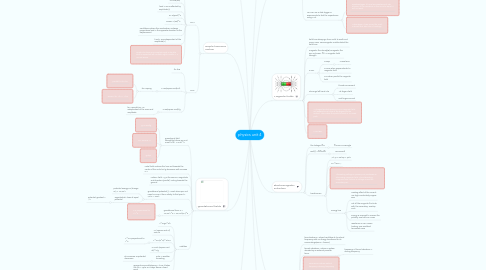
1. motion in a circle
1.1. anglar speed(w)=rate of change of an angle=angle/t = 2π/T= 2πf
1.1.1. angle= arc length(s)/radius(r)
1.2. time period(T) =time taken for 1 whole cycle= t/n=1/f
1.3. frequency(f)= number of cycles in 1 second = n/t = 1/T
1.4. a=v^2/r = w^2r
1.4.1. acts towards the centre of the circle. it is acceleration as the velociry is constantly changing
1.5. F=ma = mv^2/r = mw^2r
1.5.1. Acts towards the centre of the circle
1.6. tan(angle)=v^2/gr
2. simple harmonic motion
2.1. SHM
2.1.1. v=2πf(square root)A^2-x^2
2.1.1.1. vmax=2πfA
2.1.2. x=Acos(2πf)
2.1.3. f and T are unaffected by amplitude(A)
2.1.4. a=-x(2pief)^2
2.1.5. amax=-A(2πf)^2
2.1.6. Oscillations where the acceleration is always proportional and in the opposite direction to the displacement
2.1.7. f and T are independent of the amplitude(A)
2.1.8. Graphs to show one complete cycle is double what is expected left>middle>right>middle = 2 normal waves
2.2. SHO
2.2.1. f=-kx
2.2.2. T=2π(square root)m/k
2.2.2.1. for a spring
2.2.2.1.1. parallel k= k1+k2
2.2.2.1.2. series 1/k= 1/k1 + 1/k2
2.2.3. T=2π(square root)l/g
2.2.3.1. for a pendulum T is independent of the mass and amplitude
3. gravitational fields
3.1. graviational field strength(g)=force per unit mass= F/m = Gm/r^2
3.1.1. g= 9.8N/kg
3.1.2. G= 667x10-11
3.1.3. g=kpr
3.2. radial field is where the lines act towards the centre of the circle but g decreases with increase in r
3.3. uniform field = g is the same in magnitude and direction (parallel) acting towards the ground
3.4. gravitational potential(V) = work done per unit mass to move it from infinity to that point = W/m = -Gm/r
3.4.1. potential energy=m (change in)V= -GMm/r
3.4.2. eqipotential= lines of equal potential
3.4.2.1. potential gradient = V/r
3.5. gravitational force F = -GMm/r^2 =- GMm/(R+r)^2
3.5.1. F is proportional to 1/r^2
3.6. Satelites
3.6.1. v^2=gR^2/h
3.6.2. v= (square root of) 2GM/R
3.6.3. T^2=4(π^2)r^3/GM
3.6.3.1. T^2 is proportional to r^3
3.6.4. T= 2π/R (square root of)r^3/g
3.6.5. Polar = weather forcasting
3.6.5.1. Ek increases as potential decreases
3.6.6. geosynchronous/stationary = tv as it takes 24h for 1 cycle so it stays above a fixed point
4. Electric fields
4.1. current(I)=Qf
4.2. Like charges repel, unlike charges attract
4.3. uniform field- produced by connecting two plates to opposite sides of a battery. The current flows from + to -
4.3.1. Electric field strength(E)=force per unit charge=F/Q
4.3.1.1. E=V/d for a uniform field
4.3.2. E is the same at all points in a uniform field
4.4. Radial field
4.4.1. F=(1/4πeo) Qq/r^2
4.4.1.1. 1/4πeo = 9x10+9
4.4.1.2. E=(1/4πeo) Q/r^2
4.4.1.2.1. E=V/r
4.4.1.3. V=(1/4πeo) Q/r
4.4.2. For a point charge the field lines can point towards the particle(-ve charge) or away from the particle(+ve charge)
4.5. Work done(W)=QΔV
5. force and momentum
5.1. Momentum(p) =mxv
5.1.1. total p before = total p after
5.1.2. p is conserved in a collison but kinetic energy is not
5.1.3. Vector quality
5.1.3.1. Direction IS important
5.2. Force=change in momentum/time=Δmv/t
5.3. I=Ft=change in momentum=Δmv
5.4. no change in kinetic energy = elastic collision
6. Capacitors
6.1. capitance(C)=Q/V=charge stored per volt=It
6.1.1. Q=Qoe^(-t/RC)
6.1.2. this equation is true for Q, V, I
6.2. The negative side of the capacitor gains electrons whilst the positive end loses electrons
6.3. used in timing circuits(burglar alarm), smoothening circuits
6.4. t=CR= time taken to charge to 63% of its total or discharge to 37% total. After 5 t the capacitor is considered fully charges/discharged
6.4.1. t=-ln(Q/Qo)RC
6.5. E=1/2QV = energy stored in the capacitor as electrical potential energy
6.6. You can use a data logger in experiments to find the capacitance using C=It
6.6.1. Disadvantages: it has a low resistance of 40k ohms so if the resistance in the circuit is equal it will not work.
6.6.2. Advantages: it can record for small intervals and take lots of readings.
7. Magnetic fields
7.1. field lines always go from north to south and never cross. Ferromagnetic metals distort the field lines
7.2. magnetic flux density(B)=magnetic flux per unit area= Φ/A= magnetic field strength
7.3. F=BIL
7.3.1. F=Bqv
7.3.1.1. F=BQ/2mπ
7.3.2. F=max when perpendicular to magnetic field
7.3.3. F=0 when parallel to magnetic field
7.4. Flemings left hand rule
7.4.1. thumb=movement
7.4.2. 1st finger=field
7.4.3. 2nd finger=current
7.5. A charged particle passing into a magnetic field will experience a force at 90 degrees to the motion. This makes the particle travel in a curved path
7.6. r=mv/BQ
8. Electromagnetic induction
8.1. flux linkage=ΦN
8.1.1. ΦN=BAN.cosangle
8.2. Emf(ℰ) = ΔΦN/Δt
8.2.1. =Eo.sin2πft
8.3. transformers
8.3.1. Vs/Vp = Ns/Np = Ip/Is
8.3.2. P=I^2R= IV
8.3.3. Alternating voltage in primary coil produces an alternating magnetic field. This alternating magnetic field induces a voltage across the secondary coil.
8.3.4. Energy loss
8.3.4.1. Heating effect of the current- use high conductivity copper wire
8.3.4.2. not all the magnetic flux links with the secondary- overlap coils
8.3.4.3. energy is required to reverse the polarity- use soft iron cores
8.3.4.4. resistance in iron causes heating- use insulated, laminated cores
9. Resonance
9.1. free vibrations = object oscillates at its natural frequency with no energy transferred to its surroundings(same A forever)
9.2. forced vibrations = where a system vibrates by an external periodic force.
9.2.1. frequency of forced vibrations = driving frequency
9.3. resonance is where natural frequency=driving frequency
9.4. Dampening
9.4.1. light- takes a long time to stop oscillating, reducing a small amount each period (pendulum)
9.4.1.1. sharp resonance peak
9.4.2. heavy- displaced object returns to equilibrium without oscillation.
9.4.3. critical-reduces amplitude in the shortest time possible (car suspensions
9.4.3.1. lower resonance peak
10. Comparing fields
10.1. Similarities
10.1.1. field strength= force per unit charge/mass
10.1.2. F is proportional to 1/r^2
10.1.3. both have radial fields towards on object
10.1.4. potential= potential energy per unit mass/charge
10.2. Differences
10.2.1. gravity is always attractive, electric can be repulsive
10.2.2. Different constants
10.2.3. Cant shield from gravity unlike electrical forces
